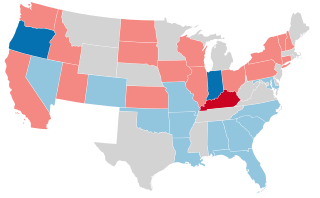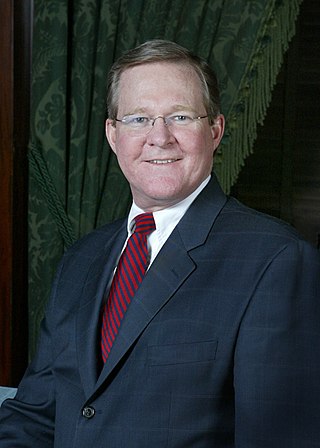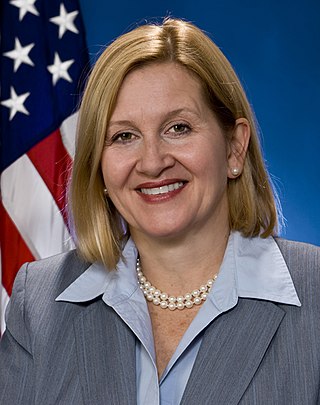
The 1908–09 United States Senate elections were held on various dates in various states. As these U.S. Senate elections were prior to the ratification of the Seventeenth Amendment in 1913, senators were primarily chosen by state legislatures. Senators were elected over a wide range of time throughout 1906 and 1907, and a seat may have been filled months late or remained vacant due to legislative deadlock. However, some states had already begun direct elections during this time. Oregon pioneered direct election and experimented with different measures over several years until it succeeded in 1907. Soon after, Nebraska followed suit and laid the foundation for other states to adopt measures reflecting the people's will. By 1912, as many as 29 states elected senators either as nominees of their party's primary or in conjunction with a general election.
The Pennsylvania Republican Party (PAGOP) is the state affiliate of the Republican Party in Pennsylvania. It is headquartered in Harrisburg. Its chair is Lawrence Tabas and is the second largest political party in the state behind the Pennsylvania Democratic Party.

Elections for the Pennsylvania State Senate were held on November 5, 2002, with even-numbered districts being contested. State Senators are elected for four-year terms, with half of the Senate seats up for a vote every two years. The term of office for those elected in 2002 ran from January 3, 2003 until November 28, 2006. Necessary primary elections were held on May 21, 2002.

Elections for the Pennsylvania State Senate were held on November 2, 2004, with even-numbered districts being contested. State Senators are elected for four-year terms, with half of the Senate seats up for a vote every two years. The term of office for those elected in 2004 will run from January 4, 2005 through November 2008. Necessary primary elections were held on April 27, 2004.

The 2006 Elections for the Pennsylvania State Senate were held on November 7, 2006, with even-numbered districts being contested. Necessary primary elections were held on May 16, 2006. State Senators are elected for four-year terms, with half of the Senate seats up for a vote every two years. Members elected in 2006 were inaugurated on January 2, 2007.

The 2006 elections for the Pennsylvania House of Representatives were held on November 7, 2006, with all districts being contested. Necessary primary elections were held on May 16, 2006. Members elected in 2006 were inaugurated on January 2, 2007. State Representatives are elected for two-year terms, with the entire House of Representatives up for a vote every two years.

Elections for the Pennsylvania State Senate were held on November 7, 2000, with even-numbered districts being contested. State Senators are elected for four-year terms, with half of the Senate seats up for a vote every two years. The term of office for those elected in 2000 ran from January 3, 2001 until November 30, 2004. Necessary primary elections were held on April 27, 2004.

Elections for the Pennsylvania State Senate were held on November 4, 2008, with odd-numbered districts being contested. Republicans had a net gain of 1 seat for the 2008 elections, expanding their majority to 30-20. State Senators are elected for four-year terms, with half of the Senate seats up for a vote every two years. The term of office for those elected in 2008 will run from December 1, 2008 until December 1, 2012. Necessary primary elections were held on April 22, 2008.

The 2004 Elections for the Pennsylvania House of Representatives were held on November 2, 2004, with all districts being contested. Necessary primary elections were held on April 27, 2004. Necessary primary elections were held on May 21, 2002. The term of office for those elected in 2004 ran from January 4, 2005 through November 2006. State Representatives are elected for two-year terms, with the entire House of Representatives up for a vote every two years.

Elections for the Pennsylvania House of Representatives were held on November 7, 2000, with all districts being contested. State Representatives are elected for two-year terms, with the entire House of Representatives up for a vote every two years. The term of office for those elected in 2000 ran from January 3, 2001, until November 30, 2002. Necessary primary elections were held on April 4, 2000.

The 2010 elections for the Pennsylvania State Senate were held on November 2, 2010, with the even-numbered districts contested. Necessary primary elections were held on May 18, 2010. The term of office for those elected in 2010 run from January 4, 2011 until November 30, 2014. State Senators are elected for four year terms, with half of the seats in the Senate up for election every two years.

The 1860–61 United States Senate elections were held on various dates in various states. As these U.S. Senate elections were prior to the ratification of the Seventeenth Amendment in 1913, senators were chosen by state legislatures. Senators were elected over a wide range of time throughout 1860 and 1861, and a seat may have been filled months late or remained vacant due to legislative deadlock. In these elections, terms were up for the senators in Class 3.

The 2012 elections for the Pennsylvania House of Representatives were held on November 6, 2012, with all districts being contested. The primary elections were held on April 24, 2012. The term of office for those elected in 2012 began when the House of Representatives convened in January 2013. Pennsylvania State Representatives are elected for two-year terms, with all 203 seats up for election every two years.

The 2014 elections for the Pennsylvania State Senate were held on November 4, 2014, with all even-numbered districts being contested. Primary elections were held on May 20, 2014.

The 2016 elections for the Pennsylvania State Senate were held on November 8, 2016, with all odd-numbered districts being contested. Primary elections were held on April 26, 2016. The term of office for those elected in 2016 began when the Senate convened in January 2017. Pennsylvania state senators are elected to four-year terms, with 25 of the 50 seats contested every two years.

The 2018 elections for the Pennsylvania State Senate were held on November 6, 2018, with 25 of 50 districts being contested. Primary elections were held on May 15, 2018. The term of office for those elected in 2018 began when the Senate convened in January 2019. Pennsylvania State Senators are elected for four-year terms, with half of the seats up for election every two years.

The 2020 elections for the Pennsylvania State Senate were held on November 3, 2020, with 25 of 50 districts being contested. Primary elections were held on June 2, 2020. The term of office for those elected in 2020 began when the Senate convened in January 2021. Pennsylvania State Senators are elected for four-year terms, with half of the seats up for election every two years. The election coincided with the 2020 United States presidential election, United States House of Representatives elections, and the entirety of the Pennsylvania House of Representatives.

The 2022 elections for the Pennsylvania State Senate were held on November 8, with 25 of 50 districts being contested. The term of office for those elected in 2022 would begin when the Senate convenes in January 2023. Pennsylvania State Senators are elected for four-year terms, with half of the seats up for election every two years. The election coincided with the 2022 United States Senate election in Pennsylvania, United States House of Representatives elections, and the election of the entirety of the Pennsylvania House of Representatives.

In the 1901 Iowa State Senate elections Iowa voters elected state senators in 21 of the state senate's 50 districts. State senators traditionally serve four-year terms in the Iowa State Senate. However, under the Biennial Elections law enacted in 1904 by the Iowa General Assembly, the senators elected in 1901 served an additional fifth year to accommodate the transition to holding elections on even-numbered years.

Elections for the Pennsylvania State Senate will be held on November 5, 2024, with 25 of 50 districts being contested. The term of office for those elected in 2024 will begin when the Senate convenes in January 2025. Pennsylvania State Senators are elected for four-year terms, with half of the seats up for election every two years. The election will coincide with the 2024 U.S. presidential election, elections to the U.S. Senate, elections to the U.S. House of Representatives, and elections to the entirety of the Pennsylvania House of Representatives.
















